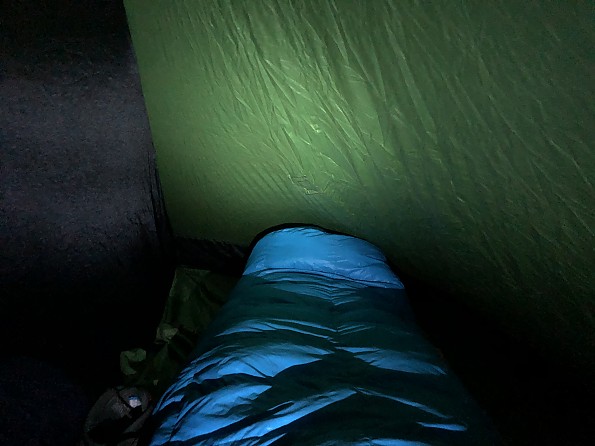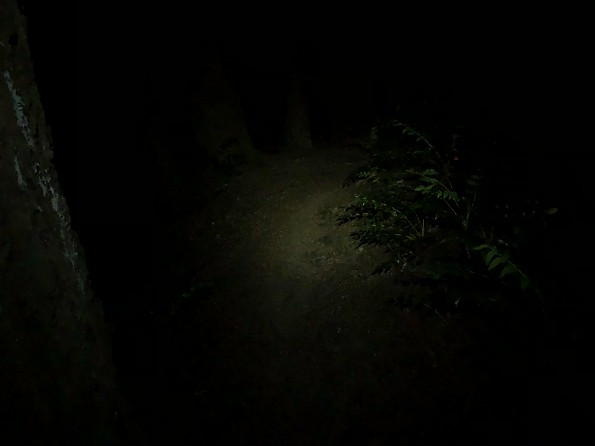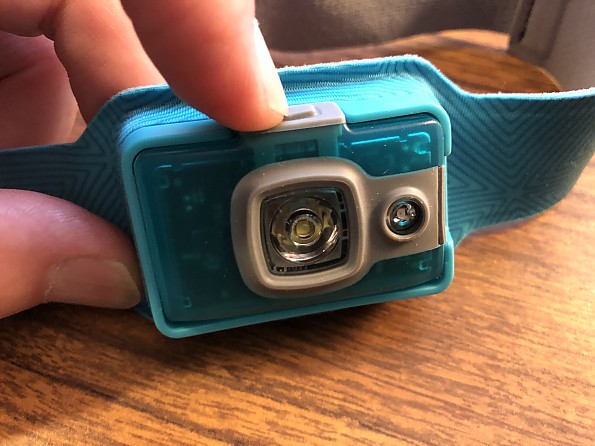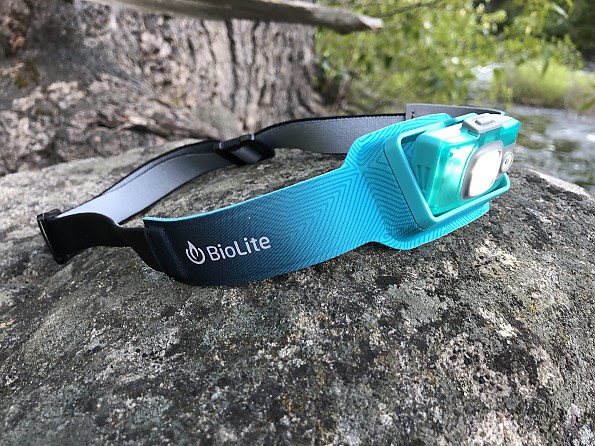BioLite HeadLamp 200

The BioLite HeadLamp 200 is a new lightweight headlamp that utilizes BioLite's unique headband design that has the advantage of being very comfortable and light. In addition, the HeadLamp 200 uses an internal/non-replaceable 700 mAh Lithium Ion battery that is charged using a micro-B USB port. The battery life is very good and should be more than adequate for multi-day trips without recharging when used at the lower power settings. Overall the BioLite HeadLamp 200 is a simply designed headlamp that would be a great addition to someone's pack.
Pros
- Very comfortable to wear for extended periods
- Textured Easy-Adjust Clips are truly easy to grip and adjust while wearing the headlamp
- Excellent battery life and exceeds advertised hours for high and low beam
- Company is Climate Neutral Certified
Cons
- Switch not the easiest to operate and even more difficult when front bezel is in angled down positions
- Battery level indicator doesn’t have enough fidelity
- Fixed front bezel angle positions—might not be right positions for different individuals‚ may be tough to get a “just right” position depending on the angle of your forehead
- Light will not function while being charged
The HeadLamp 200 is BioLite’s lightest headlamp that utilizes their unique headband design which allows the headlamp to be very comfortable, light, and compact. The headlamp has a very simple one-button control that allows you to step through the different light options and adjust the intensity of the white and red light and also is how you can lock the headlamp off to prevent it from accidentally being turned on in your pack.
The HeadLamp 200 design does not use replaceable batteries, but instead utilizes an internal Lithium Ion battery that is charged using a micro-USB port. I have experienced excellent battery life with over 3 hours at the highest 200 lumens setting and well over 40 hours at the lowest light setting.
Overall, the BioLight HeadLamp 200 is a simple well thought out design that really shines from a comfort perspective, but still delivers all of the basic features someone would be looking for in a headlamp.
The BioLight HeadLamp 200 has four basic lighting modes:
- White spot light that can be dimmed
- Red flood light that can be dimmed
- White strobe
- Red strobe
The white light has a maximum brightness of 200 lumens which I have found to be more than adequate for most of my hiking/backpacking outings with this headlamp and most of the time I have tended to use the white light towards the lower end of the dimming range.
Here is an example showing the HeadLamp 200 set at its highest and lowest white light settings. While the primary white light is a spotlight profile it still provides adequate light in the surrounding area.
While the picture above of the lowest setting may not seem like enough light, the picture doesn’t really reflect the available light and I found that I could comfortably hike the trail on the lowest setting. I am a big believer in trying to maintain your night vision while hiking at night and after your night vision develops, which takes about 30 minutes, you’ll find that you really don’t need much light from you headlamp.
Here is an example of the light output from the BioLite HeadLamp 200 in a Six Moons Design Lunar Solo. The three pictures below are in order of highest white light, lowest white light, and red flood light. I found that the lowest white light and red flood light were more than enough for me when I am in a tent and just hunting around for something I need.



Overall, I think that the BioLite HeadLamp 200 does a great job at its fundamental purpose in providing light, and I think would be more than adequate for any backcountry application.
The one caveat is that you do need to maintain an awareness of the level of light you are using along with how long you will need it, because once the HeadLamp 200 battery dies, you won't have light until you can recharge it.
Fit, Comfort, and Controls
One of the more unique features of the BioLight HeadLamp 200 is the approach taken to provide a nice comfortable fit. The electronics, battery, and light module are integrated into a molded housing that is part of the headband assembly and results in a nice smooth continuous band without any seams that contact your forehead.
Here is a picture showing the backside of the headlamp that comes in contact with your forehead.

When I have worn the headlamp at night it generally hasn’t been for very long periods of time, so to get a better assessment of the long-term comfort of the HeadLamp 200, I have worn the headlamp around for several hours while out on a hike or fishing, etc. I have found that due to the large contact patch and material used on the inner surface of the headband that I don’t have to have the band adjusted very tight for the headlamp to stay in place, which really aids in the comfort.

The headband is also made of what BioLight calls Smart Fabrics that have wicking capability to help keep you cool and dry. Cleaning of the headband has to be done manually since the headlamp can’t be removed from the headband to allow you to throw it in the wash.
Adjusting the headband while wearing the HeadLamp 200 is very easy and just involves sliding two unique clips on the headband either toward or away from each other.
Without including the elastic in the headband, I found that the headband could be adjusted from a minimum circumference of approximately 19 inches all the way up to 26 inches at its largest position. At the smallest adjustment of 19 inches the HeadLamp 200 should fit most pre-teens and older children.
The HeadLamp 200 is also comfortable to wear while lying down as there isn't any hardware on the back of the headband.
Another aspect of the fit of the BioLight HeadLamp 200 is with adjusting the angle of the headlamp to a position that works best for you, whether you are hiking or reading a book in your tent. You can only adjust the HeadLamp 200 to one of four angled positions, so depending on the angle of your forehead, the four options may work out just fine, but if you are particular about having your headlamp adjusted to just the right angle you may or may not be happy with the HeadLamp 200.
I myself found the available positions to work just fine and I primarily used just the first two detents out of the full up position. Adjusting the angle of the headlamp is easy, but I did find that operating the light switch became more difficult at any position other than at the full up and stowed position.
Due to the lightweight design and the wide support of the front portion of the headband, there is no movement/bouncing of the light which makes for a nice steady beam of light while you are walking.
Probably my least favorite feature of the BioLight HeadLamp 200 is the switch. While the switch always worked, I found it difficult to use with the pad of my finger and generally always ended up using my fingernail to operate the switch. I found the switch very difficult to use with a gloved hand.
I included the picture below so you would have better perspective of the size of the switch relative to the tip of my finger. I think that if BioLight had designed the switch to be slightly more prominent that it would have made the switch much easier to operate.
Battery Life
Since the BioLite HeadLamp 200 doesn’t have a battery you can replace and recharging takes time, the life of the battery takes on greater significance.
In the BioLite literature and website they indicate that the HeadLamp 200 should last three hours when it is on the High white light setting and forty hours when set at the lowest white light setting. I ran several timed tests at both the highest light setting and at the lowest light setting and in all of the tests the HeadLamp 200 greatly exceeded the published values from BioLite.
- Test Results: Published / Actual (Average of 3 tests)
- High Setting: 3.0 hrs / 3 hrs 25 min
- Low Setting: 40 hrs / 52 hrs 10 min
Given how small and light the HeadLamp 200 is, I was pretty impressed at the battery life, especially at the low setting. While it's great that the HeadLamp 200 can put out 200 lumens when needed, the reality is from my experience you never really need much more light then what is provided at the lowest setting for getting things done around camp or even going along a trail at night, so having a light that will go in excess of 40 hours means at least for me that I could go on a week-long trip and not have to worry about recharging the HeadLamp 200.
Charging the BioLite HeadLamp 200
The HeadLamp 200 charging system is pretty straightforward. The headlamp has a simple indicator light that is integral with the red flood light that gives you a rough idea of how much battery life is left. The following are the three indicators provided:
- Two green light flashes: Greater than 50% battery life remaining
- Two red light flashes: Less that 50% battery life remaining
- Four red flashes: Your battery is at its lowest level and needs to be recharged
For me this is a pretty coarse battery level indicator and when I see two red flashes I recharge the headlamp as I don’t know if I have 5% or 49% battery life left. This is one area where I think that BioLite could have provided greater fidelity as the current indicator is almost too coarse to be useful. It is worth noting that BioLight's more full featured HeadLamp 330 does include a higher fidelity four LED charge indicator.
Charging the HeadLamp 200 is pretty simple as you can just use the provided 20-inch long USB to micro-B USB cord to charge the HeadLamp 200 from just about any USB port or charger.
The headlamp does need to be tilted out to one of the angled positions to connect the micro USB plug to the side of the headlamp. I didn’t have any issue charging the HeadLamp 200 from any of the sources I used (computer, wall charger, and Anker battery bank that I use as a back-up power source while backpacking).
I did use a small power meter as shown in the picture below to measure the current that the HeadLamp 200 pulls while being charged and found it to be around 0.30 amps regardless of the charging method used.
The time it took to get to a full charge seemed to vary. You know the HeadLamp 200 is charging as the green indicator light slowly pulsates during the process.
BioLite states on its website that it takes 2.5 hours to get a full charge. In my testing I used the point the green light stopped pulsating as the point in time the HeadLamp 200 was fully charged, and based on the multiple charging cycles I monitored the time seem to vary from 2.5 to 3.0 hours, which is slightly longer than the published time.
When you do charge a fully depleted HeadLamp 200 it doesn’t take that long before the headlamp has enough of a charge so that the lights will again work. The HeadLamp 200 does not have a pass-through mode where you can run the light off of a battery back connected to the micro USB port, but the headlamp will function with the charging cord connected; it's just that once you turn on the headlamp it stops charging and goes back to charging once the headlamp is switched off.
Li-Ion batteries have a limited life and can be impacted with how they are charged and stored. Working through Trailspace I had the opportunity to ask BioLite a couple of questions related to the charging/storage practices and also with the expected life of the Li-Ion battery contained in the HeadLamp 200.
BioLite shared that it's always the best practice for the health of the battery to charge the battery every six months. They also shared that leaving the battery with no charge is the least desirable condition, but that charging to mid-range or full offer a similar benefit assuming the HeadLamp 200 is charged every six months. BioLite indicated that charging every six months is the best practice (and a good protocol to follow). That said, they also shared that the HeadLamp 200 can recover from an empty battery if left alone for a long time (well past a year...), but they don't recommend that kind of treatment to the battery of the HeadLamp 200.
BioLite also shared that the battery used in the HeadLamp 200 is rated for 500 cycles before any noticeable capacity degradation and even then the battery will have 70-80% of its original capacity after 500 cycles. They also shared that most Li-Ion batteries are rated between 300-500 cycles, so the batteries being used by BioLite are at the high end of expected life cycles.
Given the information shared above by BioLite, the HeadLamp 200 should provide many years of use to support all of your after-hour adventures.
Waterproofness
A headlamp is the type of gear that you really can’t afford to not have work when you run into various weather conditions on a backcountry trip. The BioLite HeadLamp 200 takes those potential adverse weather conditions into account and is designed to an IPX4 Water Resistance.
What is IPX4? Well it is an Ingress Protection Code to. IEC standard 60529. The first two are just stating that this is an Ingress Protection rating. The third character is the rating for solid intrusions like dust or sand and the “X” means that the Headlamp 200 has not undergone any testing for sand and dust. The fourth character is for water resistance and the “4” in the IPX4 rating means that the BioLite Headlamp 200 has been tested against splashing or sprayed water from any angle for some period of time.
So the IPX4 rating on the HeadLamp 200 should be more than adequate for a headlamp used for backpacking, etc., but it may not survive being dropped in a creek which would require an IPX7 rating, which includes submersion in water.
While all this technical talk may be interesting to some, I decided to do my own unofficial test. We had been having a series of rainstorms here where I live so I thought I would take advantage of the conditions and I attached the HeadLamp 200 to my climbing helmet and set the white light on a low setting, tilted out to the first setting, and then left it out in my backyard for 10 hours.

The rain, heavy at times, came and went and the HeadLamp 200 seemed to take it in stride and didn’t have any issues, so I think from my real world test is a good indicator that the HeadLamp 200 lives up to its IPX4 rating.
What’s Included

The BioLight HeadLamp 200 comes with the headlamp, a 20-inch charging cable, instruction sheet and a warranty card. The headlamp doesn’t include a USB charger which shouldn’t be an issue for 99% of the people out there.
I measured the weight of the headlamp as 1.7 ounces which is right in line with the published weight of 1.75 ounces or 50 grams.
The instruction sheet does a good job at giving you all the information you need to operate the headlamp, but if you need more info BioLite has some very nice videos on their website and here at this link.
The HeadLamp 200 also comes in four different colors: black, blue, green, and red.
One interesting thing I noticed on the packaging for the HeadLamp 200 is that BioLight is Climate Neutral Certified. I had never heard of that type of certification so I dug a little deeper and found this link here that explains it in more detail; it is nice to see BioLight stepping up to help protect the environment.
Price
The list price for the BioLite 200 is $44.95, which seems a bit high when compared to the capabilities of other headlamps available in this price range. While the BioLite Headlamp 200 is a unique and capable design, there are other headlamps in this price range that are fully waterproof, and have higher output and longer duration (though they may not be rechargeable). With the HeadLamp 200 what you are paying for is a unique design that is both very comfortable and lightweight.
Summary and Recommendation
The BioLight HeadLamp 200 is a lightweight and comfortable headlamp design that provides all the basic functions needed in a headlamp. The non-replaceable battery/rechargeable design has advantages in eliminating disposable batteries, but that is replaced by the need to manage the power level and time you use the light so that it lasts for the duration of your activity.
I think that the HeadLamp 200 would be a great headlamp for runners, but I also feel that it would be a very capable headlamp on multi-day trips as long as a power source is carried, which has become more the norm nowadays. Also, due to its light compact design the HeadLamp 200 would make a nice back-up or emergency light.
This my initial review and I have hit what I think are most of the major features, but I will be continuing to use the HeadLamp 200 for the next couple of months with a focus on seeing if there is any impact on the ability of the headlamp to hold a charge after a larger number of discharge cycles. I’ll come back in a couple of months and note any observations I see after using the HeadLamp 200 for an extended period.
Many thanks to both Trailspace and BioLite for the opportunity to evaluate and test the HeadLamp 200 for the Trailspace Gear Review Corps!
Background
I have been backpacking and climbing since the mid '70s and in that time have owned the various types of headlamps that have been available since that time. This includes a 4 D-cell Justrite headlamp that weighed way too much, all the way up to current LED headlamps made by Petzl and Black Diamond.
Source: received for testing via the Trailspace Review Corps
(Sample for testing and review provided by BioLite)
Your Review
Where to Buy
You May Like
Accessories: BioLite Light Diffusing Stuffsack,
Specs
| Price |
MSRP: $44.95 Current Retail: $29.96-$39.95 Historic Range: $15.00-$44.95 |
| Weight |
1.75 oz / 50 g |
| Lumens |
200 |
| Burn Time |
40 hours LO / 3 hours HI |
| Water Resistance |
IPX4 |
| Lighting Modes |
White + Dim, Red + Dim, White Strobe, Red Strobe |













